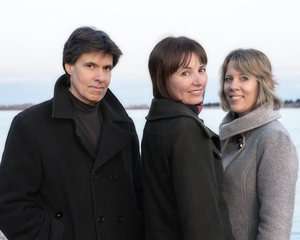|
Back
Old new music from Vienna, new new music from Calgary Toronto
Gallery 345
02/04/2018 - & February 2, 2018 (Calgary)
Hope Lee: Imaginary Garden VII
Matthew Ricketts: Graffiti Sings
Sean Clarke: Delirium Nocturnum
Arnold Schoenberg: Kammersymphonie No. 1, Opus 9 (arr. Anton Webern)
Robert Aitken (flute), James Campbell (clarinet), Land’s End Ensemble: John Lowry (violin), Beth Root Sandvoss (cello), Susanne Ruberg-Gordon (piano)

J. Lowry, B. Root Sandvoss & S. Ruberg-Gordon (© Shaun Robinson)
Toronto’s New Music Concerts hosted Calgary’s Land’s End Ensemble in a meaty program that they, along with flutist Robert Aitkin and clarinetist James Campbell, had performed at the Rozsa Centre, University of Calgary, two days previously.
The main work on the program was Arnold Schoenberg’s Chamber Symphony No. 1 (billed here as Kammersymphonie) as another instalment in an ongoing revisit to a few keys works from the Second Viennese School, widely regarded as the birthplace of so many of the ever-controversial modern “isms”. The work, premiered in 1909, was originally scored for the rather novel mix of five strings and ten wind instruments. In 1922-23 Anton Webern devised two versions for smaller groups, one of them the five-player version on this program.
Schoenberg was still composing in the late romantic style, expressionistic style of the day (Richard Strauss, a supporter, was giving the astonished world Salome and Elektra at this time) but his use of a wind-dominant group of performers seems to signal a desire to break away from the lush chromaticism that had emerged as a major feature of the music of the day, moving toward more astringent sounds. (His massive Pelleas und Melisande of 1905 is a prime example.) The chamber symphony has five linked “movements”: Allegro-Scherzo-Development-Adagio-Recapitulation and finale. Like the Alban Berg Kammerkonzert performed by New Music on January 14, it is dense with musical ideas tumbling almost madly about. It impresses more with its sheer effusiveness rather than anything else. We now know that the composer was coming to the end of his early style and was to go in a direction unforeseen by anyone.
Three contemporary Canadian works opened the program. Taiwan-born Hope Lee (born in 1953) composed Imaginary Garden VII in 2017. It has a subtitle “...until another year, another bloom...” and seems to be a memorial for the composer’s recently-deceased mother. It begins with abrupt widely-spaced notes; the pauses lengthen before longer phrases gradually emerge. After her Canadian musical education Ms. Lee studied traditional Chinese music and there are elements that hearken to that tradition, such a flutter phrases for the flute. After various contrasting episodes the 17-minute piece fades away.
Matthew Ricketts (born 1986) composed Graffiti Songs (2010) by juxtaposing new material over some of his own earlier pieces, one of them dating from his high school years. The problem with this is that the listener cannot tell the older from the newer - it is not as if he has radically changed his style (as opposed to, for example, Lukas Foss’s Baroque Variations in which Foss interposed his own notes upon recognizable pieces by Handel, D. Scarlatti, and J. S. Bach). The result is a generic, busy abstract expressionist piece.
Composer Sean Clarke (born 1983) was on hand to help introduce his piece, Delirium Nocturnum (2017). The fact that there is a strong Belgian beer of the same name is a coincidence (sort of). The piece has five sections (“Dirge”, “Aria”, “Caprice”, “Fanfare”, “Allegro con fuoco”) but they aren’t played in sequence. A portion of each section is interrupted by a portion of a contrasting section, and each has fragments that appear three or four times. The cello leads in the “Dirge” portions and there are elements of a friendly “battle” amongst the instruments. Like Hope Lee’s piece, it ends with plaintive flute measures. I don’t know if it was intentional, but it shares attributes with the Schoenberg work. It delivers rather a lot to take in at an single initial hearing.
In both the Ricketts and Clarke pieces the flute is rather frequently required to express its most stratospheric notes, which has an amplified effect in the narrow confines of Gallery 345. (Proof that there can be too much of a good thing.) It was, all in all, quite a meaty program.
Michael Johnson
|